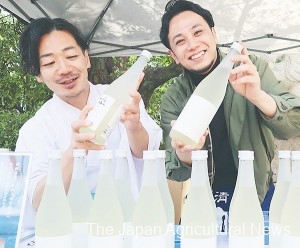HIROSHIMA, Apr. 18 – A cross-sectoral collaboration among a rice grower, a Shinto priest, and a sake brewer has begun in Hiroshima Prefecture. They brew sake, using a rice variety called Shunyo, which has achieved the highest stars in the country’s “Mieru Label” system for recognizing agricultural producers’ contributions to reducing environmental impact. The team incorporated a series of Shinto rituals into the entire process from pre-rice-planting to completing the products and named their sake “Ichimi Shinsui.” According to the Chugoku?Shikoku Regional Agricultural Administration Office of Japan, it is rare for these three sectors to collaborate in sake brewing in Japan.
Ichimi Shinsui is an old-time rite in which a group of people (ichimi) vow and unite before a local uprising by passing around a cup of sacred water (shinsui) and drinking it. The three pioneers are Tuyoshi Yasuda, a 34-year-old farmer and head of Yasuda Nosan LLC. in Miyoshi City, Hiroshima Prefecture; Hisanori Uchida, a 40-year-old senior priest at Sorasaya Inao Jinja shrine in Hiroshima City; and Yohei Hamamura, a 35-year-old master sake brewer and head of Kyokuho Shuzo sake company in Hiroshima City. The three, facing a lack of successors, joined hands to widely publicize their roles and support each other.
The sake, Ichimi Shinsui, features a usual pleasant mouthfeel of sake combined with an aroma like lychee or white grapes. Shunyo is a rice variety with a low protein content, 4 to 5 % lower than conventional ones, which makes it possible to brew sake with a clear aftertaste. Hamamura kept the temperature during the 22-day-long yeast fermentation process at 10 degrees Celsius, 4 to 5 degrees lower than usual, to slowly bring about the deep flavor and aroma.
Shunyo, produced by Yasuda, won three stars, the highest, in the Mieru Label system for both the CO2 reduction and the biodiversity. He used a robot duck to keep his rice paddies clear of weeds for three weeks after planting so that he could grow pesticide-and-fertilizer-free rice.
They incorporated traditional Japanese Shinto rituals at each milestone and watched over the whole process together. Specifically, they held ceremonies before rice planting, harvesting, and sake brewing. They produced 700 bottles and brought them to the Shrine in late March for purification by Uchida.
To catch the eye of younger generations, the bottles have a clean, simple, white label with the names of the farmer, the prayer, and the brewer. Only 700 bottles (720ml) are available at Kyokuho Shuzo, starting in April.
The party aims to make Ichimi Shinsui a staple of Hiroshima by continuing to produce it with different flavors every year. “We want to pass on our traditional industries to younger generations through this initiative,” they emphasized.


